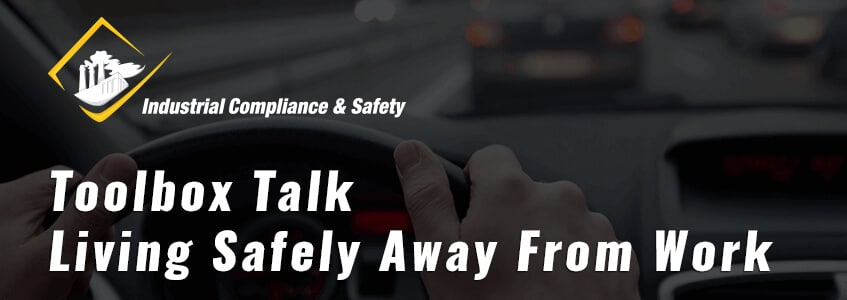Date: ____________________________________
Supervisor: _______________________________
Company Name: _____________________________
Job Name: ______________________________
So far in this series of Toolbox Talks, we have focused on safety practices that pertain to the workplace. However, it is important for your employees to adopt safety as a part of their overall lifestyles, rather than an arbitrary mode that they tap into during their shifts. As a matter of fact, contractors are statistically safer at work than they are at home. If you think about it, this makes sense. Most accidents at work happen when employees are functioning on “autopilot,” or not paying attention to their surroundings. When you are at home, you are often in a relaxed, routine state. Depending on your personal habits, these routines can be dangerous to your wellbeing and the wellbeing of those around you.
Use this Toolbox Talk to gently call attention to your employees’ habits away from work, and to remind them to take care of themselves.
Download
Guidelines for Discussion:
By now, all of you are used to thinking about safety at work. However, how many of you carry this attitude with you into your personal life? Safety must be a thing that is wholly incorporated into your lifestyle. If you work safely but are reckless at home, eventually this will catch up with you and cause physical or emotional pain in your life. After all, which is more important: your work or your life away from work? Therefore, which should you be most careful about protecting?
While driving:
- Follow the speed limit and pay attention to all traffic rules (stoplights, stop signs, and passing rules).
- Wear a safety belt, and make sure that all passengers wear theirs.
- Never drive under the influence of alcohol or drugs. If you are using a prescription that causes drowsiness or impairs your concentration, talk to your doctor about driving.
- Pay attention to the condition of your car. Change your oil within the timeframe specified by your mechanic, and make any necessary repairs (especially before long distance or rural driving).
- Leave a generous following distance between you and the car in front of you.
- Be courteous to other drivers, pedestrians, and bikers. If someone else is rude, try to give them the benefit of the doubt rather than giving in to anger/road rage.
At home:
- Look out for hazards. These could be in the form of exposed electrical wiring, slip hazards, loose fixtures, or leaks. Take the time to fix these hazards, either on your own or by hiring a professional.
- Abide by all ladder safety rules when using one at home. Don’t overextend.
- Teach your family to identify hazards.
- Know basic first aid and, if possible, CPR. Keep a first aid kit within your home, and make sure everyone knows where it is.
- Check all windows and locks to make sure they are in proper working condition. Make sure your home is fully secure when you are asleep or away.
- Routinely check all smoke detectors and carbon monoxide detectors. Place them strategically throughout your home.
In recreational activities:
- Know your body’s limits and be careful not to overexert yourself.
- Remember to stay hydrated, and always pack protein-rich snacks (like nuts and granola bars) in case your blood sugar gets low.
- Understand and follow any safety rules associated with your recreational activity (i.e., boating, hunting).
- Teach your family and friends how to play safely if they are new to an activity.
Additional Discussion Notes:
Remember, it is arguably more important to be safe at home than it is at work. By integrating safety into your daily life, you will inevitably carry that attitude into all aspects of life and provide a good example to those around you.
Disclaimer:
The information contained within this document (both the online and downloadable version) is provided for informational purposes only. Nobody shall take this as a comprehensive or exhaustive resource on this topic. This material is believed to be accurate, however, the information has been compiled from multiple sources, and so Industrial Compliance & Safety assumes no responsibility for the accuracy of this information. We encourage you to consult experts about this specific Toolbox Talk to ensure you are compliant with any and all safety regulations and processes. In no event does the content of this document supersede any applicable local, state, or federal statutes or regulations.
Safety Recommendations: _____________________
Job Specific Topics: ___________________________
Attendees:
____________________________________
____________________________________
____________________________________
____________________________________
____________________________________
____________________________________
____________________________________
____________________________________
____________________________________
____________________________________
____________________________________
____________________________________
____________________________________
____________________________________
____________________________________
____________________________________
____________________________________
____________________________________
____________________________________
____________________________________
____________________________________
____________________________________
Disclaimer
The information contained within this document (both the online and downloadable version) is provided for informational purposes only. Nobody shall take this as a comprehensive or exhaustive resource on this topic. This material is believed to be accurate, however, the information has been compiled from multiple sources, and so Industrial Compliance & Safety assumes no responsibility for the accuracy of this information. We encourage you to consult experts about this specific Toolbox Talk to ensure you are compliant with any and all safety regulations and processes. In no event does the content of this document supersede any applicable local, state, or federal statutes or regulations.





